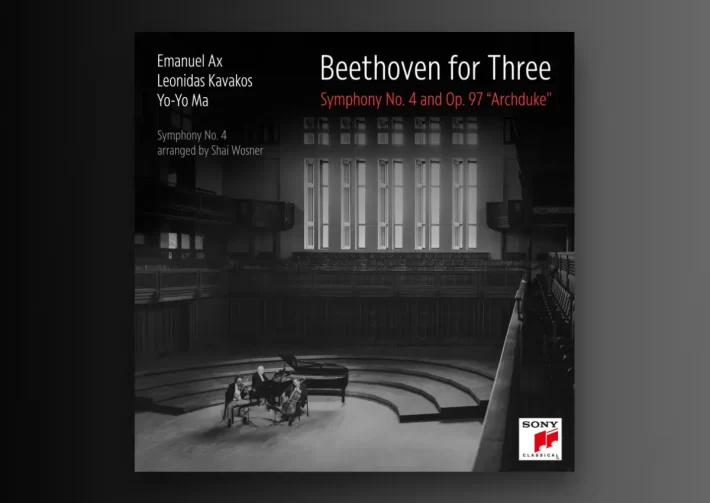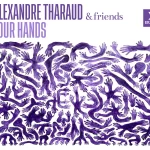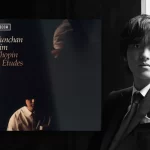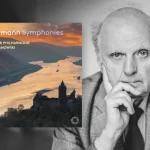As a pianist and chamber musician who has performed a fair share of Beethoven’s works, Shai Wosner is now in the depths of an ambitious project of transcribing the composer’s symphonies for a string trio. This third installment of his “Symphony for Three” series again features Leonidas Kavakos, Yo-Yo Ma, and Emanuel Ax. I had not had a chance to listen to their previous releases of Symphonies 2, 5, and 6 at the time of writing this current review, so my main point of interest was how Wosner would be able to effectively condense a work meant for a much larger ensemble.

Check offerings of “Beethoven For Three” album on Amazon.
While there is very little that can replace the multidimensional sound of different strings, winds, and brass (along with Beethoven’s energetic heft), the efforts from Wosner and the performers are not to be passed off. With many fewer outlets to work with, Wosner relies on the piano to create the weighty vertical sounds (chords and harmonies); Emanuel Ax approaches his part with enthusiasm but is also mindful to support and not overpower his colleagues. In the first movement’s thunderous section that leads up to the second theme, the trio’s sound is convincingly reminiscent of an orchestra. The arrival of the momentarily lighter material in the F major section (3’28”) shifts back to chamber mode: each player’s echo and dovetail of material is light and clear.
These instrumentalists have been playing together for some time now and their familiarity comes through in the more intricate moments like the theme of the Adagio (track 2). If you listen closely, you’ll hear how balanced and aligned the intervallic movement is between Ma and Ax’s melodies. Likewise, Wosner’s transcription involves alternating handoffs of the thematic material between the strings and piano, which are done seamlessly enough to appreciate the continuity of Beethoven’s original writing. The only issue I had was that compared to the orchestral version (for reference, I listened to the account from Yannick Nézet-Séguin with the Chamber Orchestra of Europe – Reviewed here), some of the texturing felt a little too voluminous and heavy to capture the Adagio’s charming grazioso.
Coordination is central to the Finale (track 4) and masterfully executed: Kavakos and Ma are on point with precise runs throughout, while Ax’s nimble fingerwork is evident. I especially liked Wosner’s choice at the very end (6’37”- 6’48”) to assign the lines to a singular instrument: this creates suspense and contrast from the fuller sounds prior, and adds a certain playfulness that aligns with the movement’s upbeat character. I suppose what struck me the most about the performance as a whole was the sheer amount of enthusiasm and energy Kavakos, Ma, and Ax bring to Wosner’s transcription: there’s no holding back in every bow-scrape, accent, or flurried run. While I’d say that a good part of the sound is on the heavier side to best reflect the orchestral quality, that doesn’t mean that the trio members ignore responsiveness to color and dynamics.
The Beethoven trio paired here is the Archduke, and it gives the ensemble the opportunity to showcase other aspects of their musicianship. Lyricism is a big one in the opening movement (track 5), with Ax making perceptible efforts not just to maintain the finger legato in the right hand but also similar smoothness in the accompanimental ostinato. Both Ma and Kavakos respond in kind, bringing plenty of fluid resonance to their parts. Levity takes over in outer sections of the spirited Scherzo (track 6) with precise bowing and sprightly pizzicatos that have definition but not too much of a sharp edge. Hymnlike calm and expansiveness are to be savored in the slow movement, which gives ample opportunity to grasp each player’s contemplativeness. And finally, joviality closes out the work: there’s an underlying sense of carefree, jaunty humor.
The booklet has nice photos of the performers but is otherwise frustratingly unhelpful: while these works are part of the recognizable canon, I wondered why there was no sort of description or reflection whatsoever upon Wosner’s transcription process (given how good it was) or even the trio’s insights.The sound engineers, fortunately, do better; although parts are a bit cavernous, the overall balance and capture of the “orchestra vs. trio” dynamic is well-done. The fact that this installment proved as infectiously enjoyable as it was certainly makes me want to listen to Wosner and the trio’s previous efforts. I also eagerly await future recordings in this series.


Check offerings of “Beethoven For Three” album on Amazon.
| Album Details | |
|---|---|
| Album name | “Beethoven For Three” |
| Artist | Emanuel Ax – Piano |
| Artist | Leonidas Kavakos – Violin |
| Artist | Yo-Yo Ma – Cello |
| Label | Sony Classical |
| Catalogue No. | 19658881642 |
| Amazon Link | Buy here |
| Work | Beethoven – Symphony No. 4 – Arranged for piano trio by Shai Wosner |
| Work | Beethoven – Piano Trio No. 7 in B flat Major, Op. 97 ‘Archduke’ |
Included with an Apple Music subscription:
Latest Classical Music Posts
- Review: “Four Hands” – Alexandre Tharaud
- Review: Chopin – Études – Yunchan Lim
- Review: Britten – Violin Concerto, Chamber Works – Isabelle Faust
- Review: “Mozart, You Drive Me Crazy!” – Golda Schultz, Soprano
- Review: Schumann – Complete Symphonies – Dresdner Philharmonie, Janowski
- Review: Mozart – The Sonata Project, Salzburg – Yundi, Piano
Read more classical music reviews or visit The Classic Review Amazon store
Follow Us and Comment:
Get our periodic classical music newsletter with our recent reviews, news and beginners guides.
We respect your privacy.














